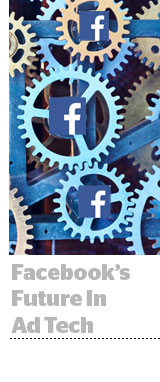 This year, Facebook appeared to abandon its plan to develop an ad tech stack to rival Google’s DoubleClick. It shut down its SSP (LiveRail), closed the Facebook Exchange and threw away its DSP before it got off the ground.
This year, Facebook appeared to abandon its plan to develop an ad tech stack to rival Google’s DoubleClick. It shut down its SSP (LiveRail), closed the Facebook Exchange and threw away its DSP before it got off the ground.
All that remains is Atlas, a former ad server repurposed as a measurement tool, and the thriving Facebook Audience Network (FAN), which reported a $1 billion run rate early this year based on its performance last Q4.
“Facebook got to a point where they needed to make a choice on whether or not to embrace the idea of an open web and biddable inventory,” said Chris Kane, founder of programmatic consultancy of Jounce Media. “They chose not to do that. Did they choose not to do that because strategically it was a bad decision? Or did they not do that because they failed?”
Perhaps it was a bit of both: Facebook backed away from a fledgling business that would force it to be more open, and focused on where it saw early success.
“It seems pretty clear that Facebook is following a publisher strategy, a supply-side strategy, as opposed to competing with Google on the demand side,” said Michael Collins, CEO of Adelphic. “At the end of the day, they are a publisher. And they are wildly successful at that.”
Even removing the buy side from the equation, a publisher-focused strategy “is a very big play,” said Mike Caprio, GM of programmatic and SVP of partnerships at Sizmek.
“They are firmly entrenching themselves into the publisher ecosystem by circumventing the traditional programmatic and direct ad channels with the use of header bidding, their SDK embedded into nearly every app on the planet and Instant Articles,” Caprio said.
That Atlas makes Facebook’s supply more measurable further supports its publisher-focused strategy. “Marketers are insisting on more direct measurement of everything they buy,” Kane said. “It’s hard for a marketer to justify spending money on media where they can’t justify performance.”
Why Atlas Changed
Market feedback led to Atlas’ repositioning.
The Atlas ad server hasn’t been a significant DoubleClick competitor since it was owned by Razorfish. Many agency clients liked Facebook’s pitch about using Atlas for people-based measurement, but dreaded the idea of switching ad servers, especially to one that lacked capabilities in all the creative formats they needed, included mobile and video.
That market response likely precipitated Facebook’s decision to pivot the product and move it into its marketing sciences division in September.
As a measurement tool, Atlas competes not against Google DoubleClick, but against attribution, measurement and media-mix tools, a category that includes Google’s Adometry and AOL’s Convertro. That competitive set improves Atlas’ chances at adoption, because Atlas was never good at the basic ad-serving task of creative delivery, Caprio confirmed.
“Google’s DoubleClick is a huge player for ad serving. Building a competitive product is not a small task,” said David Murnick, EVP of digital ops and tech for Dentsu Aegis’ media investment arm Amplifi. Dentsu’s agency clients weren’t interested in the onerous task of switching tech stacks.
Judging by adoption, other advertisers felt the same way. Adelphic’s Collins hasn’t see any uptick in Atlas adoption over the past two years on his platform. Plus, multiple sources said that AT&T, one of Atlas’ biggest remaining ad-serving clients, recently left. It will still use Atlas, but only for measurement.
“Our feedback to Facebook has consistently been that we are interested in the product as a people-based marketing and measurement solution, not as an ad server solution,” said Murnick, adding that multiple clients trialed Atlas over the past six to nine months but only as a measurement solution.
So Facebook went with what the market wanted and repositioned Atlas.
“What [Facebook] realized was that they don’t need an ad server to provide attribution and measurement,” Caprio said. “They can do that by pixeling the rest of the environment.”
The ideal use case for Atlas is when a marketer pixels all their ads with an Atlas tag to measure the effectiveness of their marketing on and off Facebook. According to Murnick, most clients trialing Atlas haven’t reached that stage yet, but have run more limited tests.
The ability to peek over the Facebook walled garden remains one of Atlas’ unique qualities. “Atlas is the one Facebook product that marketers can use across their media plan,” Kane said.
Whether that openness is just an artifact of Atlas as an ad server, or a foundation for something more, is anyone’s guess.
“Facebook making their data available through Atlas is a good thing. Better attribution and measurement will be a good thing for the industry,” Collins said. “Let’s hope that’s a first step for Facebook realizing the value of a larger programmatic ecosystem, because recently they seem to be moving away from it.”
Facebook Audience Network Today
While Facebook Audience Network lets marketers access Facebook’s audience to drive campaign goals, it does so outside of the news feed.
Facebook recommends adding Audience Network to improve campaigns. But like any ad network, buyers lack visibility and thus worry about the context of the ads and the quality of the audience clicking on those ads.
The assessment comes down to this: If the Facebook News Feed is a Rolls-Royce, Facebook Audience Network is a juiced-up Honda.
Some agencies see Audience Network diluting results, not improving them.
“Our clients are looking for conversions, sales and qualified traffic. We’ve found that Audience Network has had a negative effect on those campaigns,” said Jennifer Schaen, VP of media planning and activation at Performics, a Publicis agency.
Because of those issues, Performics doesn’t spend on Facebook Audience Network across the board. But Facebook itself? A “must-buy,” Schaen said.
Schaen is skeptical of Audience Network because it doesn’t give buyers much transparency or control, although she noted Facebook recently added the ability to blacklist sites or categories like gaming and dating.
“Transparency, and being able to see what we are doing and where we are doing it, is a big thing for us,” Schaen said.
Plus, Audience Network runs across an unknown group of publishers and mobile apps. (Facebook doesn’t disclose how many publishers run Audience Network.) The news feed offers buyers a well-defined, well-lit context.
“When [users] are on Facebook, they may be more ready to react,” Schaen said. Other contexts “may not be the right place for the user or have an adverse effect on who you are trying to target.”
Unlike Performics however, Facebook marketing partner Nanigans enabled Audience Network for 59% of its clients in Q3, according to media insights manager Andrew Waber, and “found performance generally matches or exceeds Facebook native inventory.”
Facebook Audience Network was originally designed to help mobile app marketers, and Nanigans data suggests it excels there. A Nanigans case study showed higher click-through rates when advertisers opted into Audience Network and lower costs per install. Advertisers ranged from receiving a 22% return on ad spend to just a 4% lower return on ad spend.
However, click-through-rates mean nothing if they don’t drive downstream metrics like sales or sign-ups. “Getting the impressions, the clicks – that’s OK for a lot of buyers, but that’s not OK for us,” Schaen said.
Nanigans plans to explore how Audience Network performs using downstream metrics in future research.
Recognizing this issue, Facebook recently made changes to Audience Network that allow advertisers to buy using outcomes like foot traffic or sales, which should control publishers gaming to get clicks.
A Facebook senior executive said its algorithms will only serve an ad to Audience Network if it expects performance to match the news feed.
In reality, Audience Network performance varies. Nanigans saw one advertiser’s return on ad spend go up 22% with FAN, while another’s declined 4%. But even a decline could be framed positively, since marketers are used to paying more for greater reach.
“Advertisers are willing to sacrifice CPA for reach. There’s value in that,” Kane said.
Facebook, when presented with these contrasting views, noted that a two-week test in June showed that enabling Audience Network boosted in-app purchases by 9%. Another test in early 2016 showed a 10% expansion in reach. It’s possible that Facebook Audience Network works well for some marketer goals and not for others, but neither Facebook nor Nanigans had data breaking that out.
Why They’re Survivors
Both Atlas and Audience Network support a publisher-focused strategy at Facebook.
Atlas measures a marketer’s spend at a time when marketers need to prove out the value of their advertising. Audience Network entices marketers to spend more with Facebook, even if they aren’t spending on Facebook’s O&O properties.
Consequently, Audience Network smooths out a business problem Facebook is on the cusp of facing.
Facebook’s saturated ad loads mean its astronomical 50%-plus growth rates will slow unless it finds new places to show ads. That slowdown could happen as Snapchat goes public, freeing up investors to bet on internet advertising elsewhere.
“Audience Network is a hedge against Facebook O&O [owned-and-operated] consumer traffic. Even if people aren’t on Facebook, it enables Facebook to make money,” Kane said.
While Facebook’s other ad tech products might have helped it increase off-Facebook spend too, Facebook faced a crowded field led by Google and hundreds of other companies focused on an open programmatic ecosystem. By sunsetting these buy-side tools, Facebook can focus on strengthening its mostly closed publishing ecosystem.
“What’s driving Facebook’s decision-making is share of wallet, and how they can grow their share of advertising spend,” Caprio said.













